NEW DELHI: Haunted by the "ghosts of Balakot", IAF chief Amar Preet Singh on Saturday came fully armed with more visual proof of the precision airstrikes carried out deep inside Pakistan during Operation Sindoor , showcasing the extent of damage inflicted on key military and terror infrastructure.
From high-value airbases to the headquarters of ISI-backed terror outfits, the strikes, conducted in retaliation to the Pahalgam killings, demonstrated India’s ability to hit strategic targets with pinpoint accuracy, well inside enemy territory.
"I'm very happy that this time we were able to take care of that ghost of Balakot that we were able to tell the world what we have achieved," the IAF chief remarked.
The evidence included images and videos of the destruction of Pakistan’s Nur Khan Airbase in Rawalpindi, the flattening of Jaish-e-Mohammed ’s command centre in Bahawalpur, and crippling damage to Lashkar-e-Taiba ’s headquarters in Muridke. The IAF also presented proof of severe hits on the Rahim Yar Khan, Sukkur, and Bholari airbases.

Nur Khan airbase
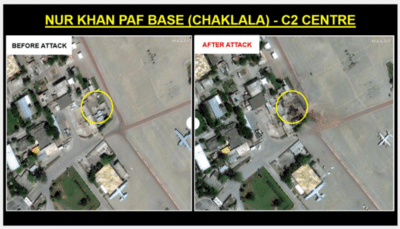
The strikes inflicted a significant setback on Pakistan’s military capabilities by destroying the Nur Khan Airbase, a key pillar of the country’s air power, during precision strikes under Operation Sindoor.
Located in Rawalpindi and formerly known as PAF Chaklala, the base served as the command hub of Pakistan’s Air Mobility Command. It housed critical aerial assets such as Saab Erieye airborne early warning aircraft, C-130 transport planes, and IL-78 aerial refuelling tankers.
Bahawalpur: JeM headquarters

IAF's precision strikes under Operation Sindoor caused tremendous damage to Jaish-e-Mohammed’s headquarters in Bahawalpur, Pakistan, the ISI-backed terror group’s main command hub.
Among those killed were ten members of JeM chief Masood Azhar’s family, marking a major blow to the group’s leadership.
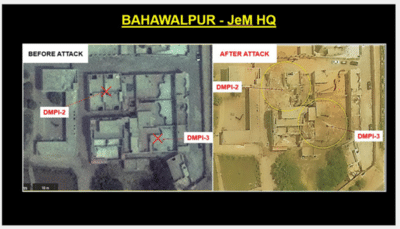
Carried out nearly 100 kilometres inside Pakistani territory, the strike was described as the most powerful of the operation, employing India’s most potent weapon.
In total, the armed forces eliminated nine terror launchpads, but the Bahawalpur hit was considered the most significant for both strategic and symbolic reasons.
Muridke: LeT headquarters
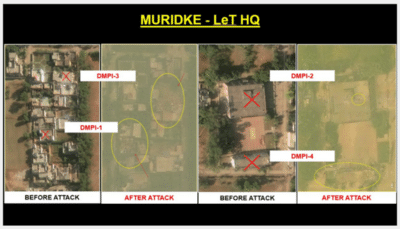
Another key terror site that IAF had targeted was Muridke, where Lashkar-e-Taiba's headquarters was located.
Demonstrating the level of damage caused by the strikes, IAF chief said, "This is their senior leadership's residential area. These were their office building where they would get together to conduct meetings. We could get video from the weapons themselves as the location was within range."
The strikes killed around a dozen high-value terrorists in Pakistan, including IC-814 hijacker Yusuf Azhar, Lashkar’s Muridke chief Abu Jundal alias Mudassar, and the son of the 2016 Nagrota attack plotter.
Rahim Yar Khan airbase

The damages at the Rahim Yar Khan airbase from Operation Sindoor was so intense that it remained non-operational for at least two months.
The base, located about 230 km south of Bahawalpur, is a key element of Pakistan’s southern air defence due to its proximity to India’s Rajasthan border and was heavily damaged in India’s precision strikes in early May.
Situated within an international airport, the airbase first issued a Notam on May 10, closing the runway until May 18, which was later extended. Another closure notice followed in early June, pushing the date to July 4.
Sukkur airbase
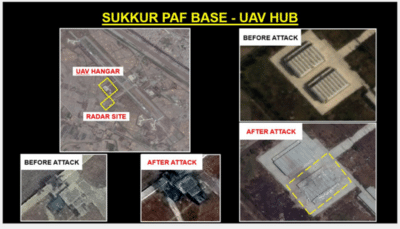
The image shows the before and after scenes at Sukkur Pakistani airbase. Its dual-use radar was targeted as it is located very close to Rajasthan and used for nefarious activities.
Bholari airbase
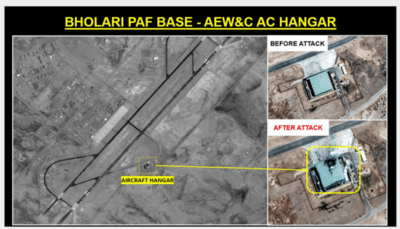
At Bholari, strikes targeted the AEW&C hangar.
"We attacked three hangars. One was the Sukkur UAV hangar, the Bholari hangar and the Jacobabad F-16 hangar. We have an indication of at least one AEW&C in that AEW&C hangar and a few F-16s, which were under maintenance there," IAF chief said.
Singh on Saturday said the forces shot down five Pakistani jets and one airborne early warning and control (AEW&C) aircraft during the Operation Sindoor. The IAF Chief’s remark is the first confirmation from any high-ranking official of the number of Pakistani jets India damaged during its cross-border anti-terror operation.
He also said that India's air defence systems did a wonderful job and praised the S-400 system, calling it a game-changer.
"Our air defence systems have done a wonderful job. The S-400 system, which we had recently bought, has been a game-changer. The range of that system has really kept their aircraft away from their weapons like, those long-range glide bombs that they have, they have not been able to use any one of those because they have not been able to penetrate the system," the IAF chief said.
Read | J&K: 2 soldiers killed as 9-day Kashmir gunfight grinds on
'No Pakistani aircraft could come near the boundaries of Akash'
He said that as far as India's offensive was concerned, "that night we didn't have any hold bar and we decided that we would go attack at Pan Front, we would stretch resources".
"None of their aircraft could come anywhere near the boundaries of Akash and even MRSAM. All their aircraft were taken on by LRSAM because they were trying to stay away, but still they were within our range at times, and that is the opportunity targets that we got. As far as our offensive was concerned, that night we didn't have any hold bar and we decided that we would go attack at Pan Front, we would stretch resources. The idea was once again not to attack one particular airfield and decimate that airfield. The idea was to give him that feeling or give him that indication that look, we can attack you deep inside, at will, wherever we want to...Bholari, an AEW&C hangar, was attacked. And here we have a very clear hint that there was an aircraft in sight when this attack took place," he said.
Hardly any collateral near Jaish-e-Mohammad's headquarters
Showing the before and after images of the damage India caused at Bahawalpur, where the terror outfit Jaish-e-Mohammed's headquarters are located, Singh said: "There's hardly any collateral here... The adjacent buildings are fairly intact... Not only did we have satellite pictures, but also from local media, through which we could get inside pictures."
The IAF chief said: "People got down to their egos in the war... Once we achieved our objective, we should have looked for all windows of opportunity to stop... Some people very close to me said, 'Aur maarna tha'. But can we continue to be at war?... The nation has taken a good decision."
From high-value airbases to the headquarters of ISI-backed terror outfits, the strikes, conducted in retaliation to the Pahalgam killings, demonstrated India’s ability to hit strategic targets with pinpoint accuracy, well inside enemy territory.
"I'm very happy that this time we were able to take care of that ghost of Balakot that we were able to tell the world what we have achieved," the IAF chief remarked.
The evidence included images and videos of the destruction of Pakistan’s Nur Khan Airbase in Rawalpindi, the flattening of Jaish-e-Mohammed ’s command centre in Bahawalpur, and crippling damage to Lashkar-e-Taiba ’s headquarters in Muridke. The IAF also presented proof of severe hits on the Rahim Yar Khan, Sukkur, and Bholari airbases.
Nur Khan airbase
The strikes inflicted a significant setback on Pakistan’s military capabilities by destroying the Nur Khan Airbase, a key pillar of the country’s air power, during precision strikes under Operation Sindoor.
Located in Rawalpindi and formerly known as PAF Chaklala, the base served as the command hub of Pakistan’s Air Mobility Command. It housed critical aerial assets such as Saab Erieye airborne early warning aircraft, C-130 transport planes, and IL-78 aerial refuelling tankers.
Bahawalpur: JeM headquarters

IAF's precision strikes under Operation Sindoor caused tremendous damage to Jaish-e-Mohammed’s headquarters in Bahawalpur, Pakistan, the ISI-backed terror group’s main command hub.
Among those killed were ten members of JeM chief Masood Azhar’s family, marking a major blow to the group’s leadership.
Carried out nearly 100 kilometres inside Pakistani territory, the strike was described as the most powerful of the operation, employing India’s most potent weapon.
In total, the armed forces eliminated nine terror launchpads, but the Bahawalpur hit was considered the most significant for both strategic and symbolic reasons.
Muridke: LeT headquarters
Another key terror site that IAF had targeted was Muridke, where Lashkar-e-Taiba's headquarters was located.
Demonstrating the level of damage caused by the strikes, IAF chief said, "This is their senior leadership's residential area. These were their office building where they would get together to conduct meetings. We could get video from the weapons themselves as the location was within range."
The strikes killed around a dozen high-value terrorists in Pakistan, including IC-814 hijacker Yusuf Azhar, Lashkar’s Muridke chief Abu Jundal alias Mudassar, and the son of the 2016 Nagrota attack plotter.
Rahim Yar Khan airbase

The damages at the Rahim Yar Khan airbase from Operation Sindoor was so intense that it remained non-operational for at least two months.
The base, located about 230 km south of Bahawalpur, is a key element of Pakistan’s southern air defence due to its proximity to India’s Rajasthan border and was heavily damaged in India’s precision strikes in early May.
Situated within an international airport, the airbase first issued a Notam on May 10, closing the runway until May 18, which was later extended. Another closure notice followed in early June, pushing the date to July 4.
Sukkur airbase
The image shows the before and after scenes at Sukkur Pakistani airbase. Its dual-use radar was targeted as it is located very close to Rajasthan and used for nefarious activities.
Bholari airbase
At Bholari, strikes targeted the AEW&C hangar.
"We attacked three hangars. One was the Sukkur UAV hangar, the Bholari hangar and the Jacobabad F-16 hangar. We have an indication of at least one AEW&C in that AEW&C hangar and a few F-16s, which were under maintenance there," IAF chief said.
Singh on Saturday said the forces shot down five Pakistani jets and one airborne early warning and control (AEW&C) aircraft during the Operation Sindoor. The IAF Chief’s remark is the first confirmation from any high-ranking official of the number of Pakistani jets India damaged during its cross-border anti-terror operation.
He also said that India's air defence systems did a wonderful job and praised the S-400 system, calling it a game-changer.
"Our air defence systems have done a wonderful job. The S-400 system, which we had recently bought, has been a game-changer. The range of that system has really kept their aircraft away from their weapons like, those long-range glide bombs that they have, they have not been able to use any one of those because they have not been able to penetrate the system," the IAF chief said.
Read | J&K: 2 soldiers killed as 9-day Kashmir gunfight grinds on
'No Pakistani aircraft could come near the boundaries of Akash'
He said that as far as India's offensive was concerned, "that night we didn't have any hold bar and we decided that we would go attack at Pan Front, we would stretch resources".
"None of their aircraft could come anywhere near the boundaries of Akash and even MRSAM. All their aircraft were taken on by LRSAM because they were trying to stay away, but still they were within our range at times, and that is the opportunity targets that we got. As far as our offensive was concerned, that night we didn't have any hold bar and we decided that we would go attack at Pan Front, we would stretch resources. The idea was once again not to attack one particular airfield and decimate that airfield. The idea was to give him that feeling or give him that indication that look, we can attack you deep inside, at will, wherever we want to...Bholari, an AEW&C hangar, was attacked. And here we have a very clear hint that there was an aircraft in sight when this attack took place," he said.
Hardly any collateral near Jaish-e-Mohammad's headquarters
Showing the before and after images of the damage India caused at Bahawalpur, where the terror outfit Jaish-e-Mohammed's headquarters are located, Singh said: "There's hardly any collateral here... The adjacent buildings are fairly intact... Not only did we have satellite pictures, but also from local media, through which we could get inside pictures."
The IAF chief said: "People got down to their egos in the war... Once we achieved our objective, we should have looked for all windows of opportunity to stop... Some people very close to me said, 'Aur maarna tha'. But can we continue to be at war?... The nation has taken a good decision."
You may also like

Pakistan general makes extraordinary nuclear threat from US soil

Luxury high rise bans delivery drivers over 'illegal migrant workers' claims

PM Modi inaugurates Yellow line of Bangalore Metro Rail

Earthquake of magnitude 6.1 strikes western Turkey, disaster authority says

Vladimir Putin's dad 'gouged out his mum's eye with pitchfork in fit of rage'







